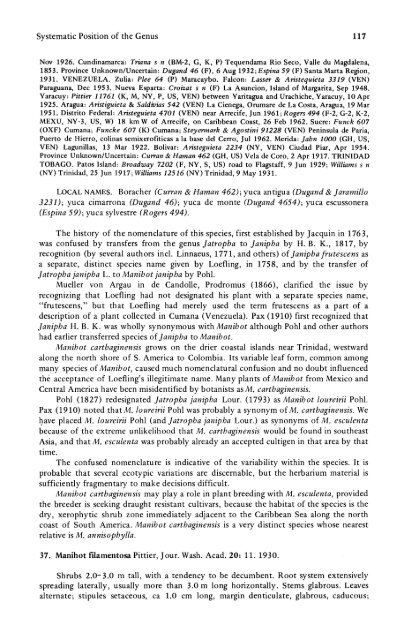Manihot Manihotoides (Euphorbiaceae) - CNCFlora
Manihot Manihotoides (Euphorbiaceae) - CNCFlora
Manihot Manihotoides (Euphorbiaceae) - CNCFlora
Create successful ePaper yourself
Turn your PDF publications into a flip-book with our unique Google optimized e-Paper software.
Systematic Position of the Genus 117<br />
Nov 1926. Cundinamarca: Triana s n (BM-2, G, K, P) Tequendama Rio Seco, Valle du Magdalena,<br />
1853. Province Unknown/Uncertain: Dugand 46 (F), 6 Aug 1932; Espina 59 (F) Santa Marta Region,<br />
1931. VENEZUELA. Zulia: Plee 64 (P) Maracaybo. Falcon: Lasser & Aristequieta 3319 (VEN)<br />
Paraguana, Dec 1953. Nueva Esparta: Croizat s n (F) La Asuncion, Island of Margarita, Sep 1948.<br />
Yaracuy: Pittier 11761 (K, M, NY, P, US, VEN) between Yaritagua and Urachiche, Yaracuy, 10 Apr<br />
1925. Aragua: Aristiguieta & Saldivias 542 (VEN) La Cienega, Orumare de La Costa, Aragua, 19 Mar<br />
1951. Distrito Federal: Aristeguieta 4701 (VEN) near Arrecife, Jun 1961; Rogers 494 (F-2, G-2, K-2,<br />
MEXU, NY-3, US, W) 18 km W of Arrecife, on Caribbean Coast, 26 Feb 1962. Sucre: Funck 607<br />
(OXF) Cumana; Funcke 607 (K) Cumana; Steyermark & Agostini 91228 (VEN) Peninsula de Paria,<br />
Puerto de Hierro, colinas semixerofiticas a la base del Cerro, Jul 1962. Merida: Jahn 1000 (GH, US,<br />
VEN) Lagunillas, 13 Mar 1922. Bolivar: Aristeguieta 2234 (NY, VEN) Ciudad Piar, Apr 1954.<br />
Province Unknown/Uncertain: Curran & Haman 462 (GH, US) Vela de Coro, 2 Apr 1917. TRINIDAD<br />
TOBAGO. Patos Island: Broadway 7202 (F, NY, S, US) road to Flagstaff, 9 Jun 1929; Williams s n<br />
(NY) Trinidad, 25 Jun 1917; Williams 12516 (NY) Trinidad, 9 May 1931.<br />
LOCAL NAMES. Boracher (Curran & Haman 462); yuca antigua (Dugand & Jaramillo<br />
3231); yuca cimarrona (Dugand 46); yuca de monte (Dugand 4654); yuca escussonera<br />
(Espina 59); yuca sylvestre (Rogers 494).<br />
The history of the nomenclature of this species, first established by Jacquin in 1763,<br />
was confused by transfers from the genus Jatropha to Janipha by H. B. K., 1817, by<br />
recognition (by several authors incl. Linnaeus, 1771, and others) of Janipha frutescens as<br />
a separate, distinct species name given by Loefling, in 1758, and by the transfer of<br />
Jatropha janipha L. to <strong>Manihot</strong> janipha by Pohl.<br />
Mueller von Argau in de Candolle, Prodromus (1866), clarified the issue by<br />
recognizing that Loefling had not designated his plant with a separate species name,<br />
"frutescens," but that Loefling had merely used the term frutescens as a part of a<br />
description of a plant collected in Cumana (Venezuela). Pax (1910) first recognized that<br />
Janipha H. B. K. was wholly synonymous with <strong>Manihot</strong> although Pohl and other authors<br />
had earlier transferred species of Janipha to <strong>Manihot</strong>.<br />
<strong>Manihot</strong> carthaginensis grows on the drier coastal islands near Trinidad, westward<br />
along the north shore of S. America to Colombia. Its variable leaf form, common among<br />
many species of <strong>Manihot</strong>, caused much nomenclatural confusion and no doubt influenced<br />
the acceptance of Loefling's illegitimate name. Many plants of <strong>Manihot</strong> from Mexico and<br />
Central America have been misidentified by botanists as M. carthaginensis.<br />
Pohl (1827) redesignated Jatropha janipha Lour. (1793) as <strong>Manihot</strong> loureirii Pohl.<br />
Pax (1910) noted thatM. loureirii Pohl was probably a synonym of M. carthaginensis. We<br />
have placed M. loureirii Pohl (and Jatropha janipha Lour.) as synonyms of M. esculenta<br />
because of the extreme unlikelihood that M. carthaginensis would be found in southeast<br />
Asia, and that M. esculenta was probably already an accepted cultigen in that area by that<br />
time.<br />
The confused nomenclature is indicative of the variability within the species. It is<br />
probable that several ecotypic variations are discernable, but the herbarium material is<br />
sufficiently fragmentary to make decisions difficult.<br />
<strong>Manihot</strong> carthaginensis may play a role in plant breeding with M. esculenta, provided<br />
the breeder is seeking draught resistant cultivars, because the habitat of the species is the<br />
dry, xerophytic shrub zone immediately adjacent to the Caribbean Sea along the north<br />
coast of South America. <strong>Manihot</strong> carthaginensis is a very distinct species whose nearest<br />
relative is M. annisophylla.<br />
37. <strong>Manihot</strong> filamentosa Pittier, Jour. Wash. Acad. 20: 11. 1930.<br />
Shrubs 2.0- 3.0 m tall, with a tendency to be decumbent. Root system extensively<br />
spreading laterally, usually more than 3.0 m long horizontally. Stems glabrous. Leaves<br />
alternate; stipules setaceous, ca 1.0 cm long, margin denticulate, glabrous, caducous;

















